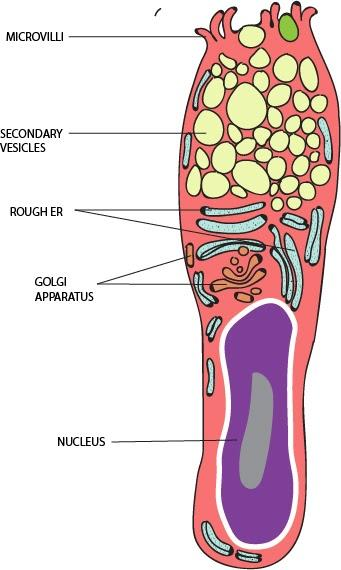
What is the function of a goblet cell?
Answer
510k+ views
Hint: Goblet cells are those that are concerned with mucus production in the body. They function exactly like exocrine (duct bearing) glands secreting mucus into respective organs.
Complete answer:
Goblet cells are merocrine producers of semi-solid and salty fluid called mucus. Though they are not glands yet their method of functioning makes it appear as an exocrine gland (that uses ducts to secrete its fluid). However, its structure is such that its opening is through a duct like villi (hair like structure) that imparts secreting mucus a gland like image.
Following are enlisted few of the functions of the goblet cells:
1. Manufacturing of mucus that helps in absorption of nutrients directly into the blood.
2. Frames a protective mucosal layer that engulfs harmful microorganisms thus, protects the organ.
3. Production of moisty mucus that provides lubrication to the organs while functioning.
Mucus is one of the most important fluids produced in the body. It is a kind of a glycoprotein that has comparatively higher molecular weight than others. Its physical state varies from semi-solid to liquid depending upon its need. It serves various functions while reciting inside the organ. It is generally produced in the inner lining of the organ through goblet cells. These goblet cells are producers of the mucosal layer inside any organ, especially the small and
large intestines.

Note:
The entire epithelial length of intestines have a covering of mucus as it helps in digestion. It is generally found in the epithelium layer of various organs in order to provide protection along with lubrication.
Complete answer:
Goblet cells are merocrine producers of semi-solid and salty fluid called mucus. Though they are not glands yet their method of functioning makes it appear as an exocrine gland (that uses ducts to secrete its fluid). However, its structure is such that its opening is through a duct like villi (hair like structure) that imparts secreting mucus a gland like image.
Following are enlisted few of the functions of the goblet cells:
1. Manufacturing of mucus that helps in absorption of nutrients directly into the blood.
2. Frames a protective mucosal layer that engulfs harmful microorganisms thus, protects the organ.
3. Production of moisty mucus that provides lubrication to the organs while functioning.
Mucus is one of the most important fluids produced in the body. It is a kind of a glycoprotein that has comparatively higher molecular weight than others. Its physical state varies from semi-solid to liquid depending upon its need. It serves various functions while reciting inside the organ. It is generally produced in the inner lining of the organ through goblet cells. These goblet cells are producers of the mucosal layer inside any organ, especially the small and
large intestines.

Note:
The entire epithelial length of intestines have a covering of mucus as it helps in digestion. It is generally found in the epithelium layer of various organs in order to provide protection along with lubrication.
Recently Updated Pages
Why are manures considered better than fertilizers class 11 biology CBSE

Find the coordinates of the midpoint of the line segment class 11 maths CBSE

Distinguish between static friction limiting friction class 11 physics CBSE

The Chairman of the constituent Assembly was A Jawaharlal class 11 social science CBSE

The first National Commission on Labour NCL submitted class 11 social science CBSE

Number of all subshell of n + l 7 is A 4 B 5 C 6 D class 11 chemistry CBSE

Trending doubts
Differentiate between an exothermic and an endothermic class 11 chemistry CBSE

10 examples of friction in our daily life

One Metric ton is equal to kg A 10000 B 1000 C 100 class 11 physics CBSE

Difference Between Prokaryotic Cells and Eukaryotic Cells

1 Quintal is equal to a 110 kg b 10 kg c 100kg d 1000 class 11 physics CBSE

State the laws of reflection of light




